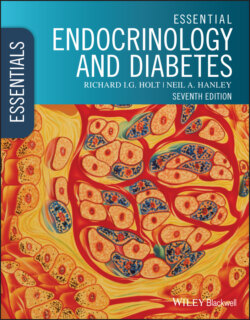Читать книгу Essential Endocrinology and Diabetes - Richard I. G. Holt - Страница 78
Endocrine transcription factors
ОглавлениеOther transcription factors play roles in development and regulating mature function comparable to some of the orphan and variant nuclear receptors although they are not part of the nuclear receptor superfamily (Table 3.4). This is important because inactivating mutations in these transcription factors cause endocrine pathology, particularly in the paediatric setting. For instance, pituitary‐specific transcription factor 1 (PIT1) regulates expression of the genes encoding GH, PRL and the β‐subunit of TSH. People with inactivating PIT1 mutations show loss of these hormones, causing short stature, and a developmental secondary hypothyroidism accompanied by severe learning disability. Via whole‐exome and, increasingly, whole‐genome sequencing, clinical genetics and genomics can provide increasingly precise diagnostic answers to these developmental endocrinology problems (Chapter 4).
Figure 3.19 The nuclear hormone receptor superfamily. The receptors, named according to their ligands (shown to the right), range in size from 395 to 984 amino acids.
Table 3.2 Examples of modifications to hormones, their precursors or metabolites within the cell prior to nuclear receptor action
| Modification that increases activity | Modification that decreases activity |
|---|---|
| Deiodination of thyroxine (T4) to tri‐iodothyronine (T3) by type 1 and type 2 selenodeiodinase (Figure 8.7) | Inactivation of T4 and T3 by the formation of reverse T3 and di‐iodothyronine (T2) by type 3 selenodeiodinase (Figure 8.7) |
| Reduction of testosterone to dihydrotestosterone (DHT) by 5α‐reductase (Figure 7.7); sex steroid function in males by local conversion of testosterone to oestradiol by the action of aromatase (CYP19; e.g. in bone; Figure 2.6) | Loss of androgenic activity by conversion of testosterone to oestradiol by the action of aromatase (CYP19; Figure 2.6) |
| Conversion of 25‐hydroxyvitamin D to 1,25‐dihydroxyvitamin D (calcitriol) by 1α‐hydroxylase (Figure 9.2) | Conversion of 25‐hydroxyvitamin D to 24,25‐dihydroxyvitamin D or the inactivation of 1,25‐dihydroxyvitamin D to 1,24,25‐trihydroxyvitamin D by 24α‐hydroxylase (Figure 9.2) |
| Generation of cortisol from cortisone by type 1 11β‐hydroxysteroid dehydrogenase (HSD11B1; Figure 6.4) | Inactivation of cortisol to cortisone by Type 2 11β‐hydroxysteroid dehydrogenase (HSD11B2; Figure 6.4) |
The biological importance of these modifying enzymes is exemplified by rare mutations in the genes that encode them, presenting with endocrine over‐activity or under‐activity.
The development of the pancreas and, in particular, the specification and function of β‐cells, which secrete insulin, relies on a considerable number of transcription factors. Pancreas duodenal homeobox factor 1 [PDX1, also called insulin promoter factor 1 (IPF1)] and several members of the hepatocyte nuclear factor (HNF) family are critical; inactivating mutations cause monogenic diabetes mellitus at an early age, also called ‘maturity‐onset diabetes of the young’ (MODY) (Table 11.3). Evidence suggests these individuals never accrue a full complement of β‐cells, which also fail to function properly. Interestingly, it is emerging that more subtle under‐functioning of these transcription factors, for instance, due to genetic variations in their regulatory enhancers and promoters, is associated with type 2 diabetes.
Figure 3.20 Nuclear hormone receptor–DNA interactions. (a) Steroid hormone receptors form homodimers bound to palindromic hexanucleotide target DNA sequences that comprise the hormone response element (HRE). (b) Thyroid hormone receptor (TR), similar to receptors for retinoic acid and calcitriol, forms heterodimers with the retinoid X receptor. (c) Once occupied by tri‐iodothyronine (T3), DNA‐bound TR recruits co‐activator proteins which, in turn, bridge to, activate and stabilize the multiple components of the transcription initiation complex at the basal promoter of the target gene.
Table 3.3 Defects in nuclear hormone signalling
| Mutations in genes encoding | Clinical effects |
|---|---|
| Androgen (AR) | Partial or complete androgen insensitivity syndromes |
| Glucocorticoid (GR) | Generalized inherited glucocorticoid resistance |
| Oestrogen (ER) | Oestrogen resistance |
| Thyroid hormone (TR) | Thyroid hormone resistance |
| Vitamin D (VDR) | Vitamin D (calcitriol)‐resistant rickets |
Table 3.4 Examples of important transcription factors required for the development and function of endocrine cell types and organs
| Organ or cell type | Transcription factor |
|---|---|
| Adrenal gland | SF‐1 (NR5A1), DAX1 (NR0B1), CITED2 |
| Enteroendocrine cells | NEUROG3 (NGN3) |
| Gonad | WT1, SRY, SOX9, SF‐1, DAX1 |
| Pancreas/islets of Langerhans | PDX1, PTF1A, SOX9, HLXB9, NGN3, PAX6, PAX4, RFX6, NKX2.2, NKX6.1, NeuroD1 (also see Table 13.3) |
| Parathyroid gland | TBX1 (part of Di George syndrome; see Figure 4.4), GATA3 |
| Pituitary | PIT1, PROP1, HESX1, PITX2, SF‐1, DAX1, LHX3, LHX4 |
| Thyroid gland | PAX8, FOXE1, NKX2.1 |
Alternative names for some transcription factors are given in parentheses
